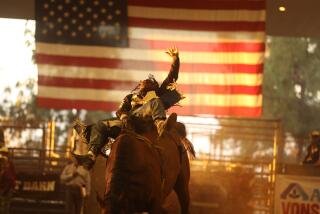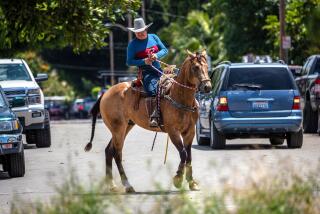He Teaches Israeli Cowboys the Ropes
- Share via
VERED HAGALIL, Israel — What does a seventh-generation Californian do after he’s been a rodeo rider, ballroom dance teacher, encyclopedia salesman and advertising mogul?
Well, if his name is Art Gayton, and he’s read a lot of Dale Carnegie self-help books, he comes to Israel to teach horsemanship to a bunch of Israeli cowboys who are convinced that they know more than he does about the subject.
Dude Ranch Owner
Yehuda Avni, owner of a dude ranch here, who along with the Israeli Cattlemen’s Assn. co-sponsored Gayton’s training clinics for Israeli horsemen and their mounts, concedes that Israelis can be “a little cocky.”
“I see how the boys ride,” Avni said, “and I think God keeps them in the saddle.”
Gayton, a guest in Israel whose normal classroom is the Paddock Riding Club of Glendale, is more diplomatic.
“If a person came in and wasn’t told about the Israeli attitude, he’d be intimidated very quick,” he said. “Most of them come to a course to teach the teacher. They’re very Missouri-ish--’Show me!’ ”
But that’s the kind of challenge Gayton, 53, seems to enjoy, and he has dealt with the peculiarities of the Israeli character well enough that this was his second teaching trip here.
When Avni brought Gayton in the first time, last December, “he made a revolutionary impact,” the dude ranch owner said. He added: “Men who had been working with horses for 10, 15, 20 years saw that they had something to learn.”
Thus the repeat performance, and the planning is already well along for a third trip next April.
Israel, although it is not famous as a horse-loving country, has a nascent breeding industry, some cattle to herd, and a growing number of pleasure riders. According to the Ministry of Agriculture, Israel has 15,000 horses.
Several hundred Israeli “cowboys” work on cattle-raising collectives or cooperative farms. There are half a dozen good stables teaching English show riding and a few Western-style pleasure riding centers like Vered Hagalil. The cowboys, though, are all untrained, Avni said.
“Most are self-taught,” he went on. “They’ve never had a chance to see what expertise can do.”
Some who have come to his seminars didn’t know how to coil a rope, Gayton said. The Israeli horsemen don’t look much like cowboys, either. A handful at his seminar here the other day wore Western-style hats, a couple had cowboy boots and one even carried a sidearm in a holster; but they were exceptions. Most wore ordinary street clothes.
Barefoot and in Shorts
A participant in an earlier clinic showed up barefoot and in shorts, Gayton noted, and that’s the way he rode. “You talk about tough!” the Californian added with a shake of his head.
But, Gayton said, “I’m not here to dress them,” and the Israeli cowboys have proved to be good students--once he got their attention. And for that, he has a few tricks. One of the first things he does is pick a horse at random and train him within minutes to follow him around the ring or corral without any rope or rein.
Another one he learned many years ago from a Yaqui Indian. “Anybody here have a horse that won’t go in a trailer?” Gayton asks, knowing that there is always at least one.
“I’ll tell you what this horse is going to do. In about two minutes after I handle him, I’ll show him the trailer. It will take three minutes more and he’ll be in the trailer, but I’ll lead him in. Then, in another 10 minutes, I’ll just stand here, drop the gate, and he’ll jump in.”
At that point, Gayton said, his students have “got the hook as far in them as it can get.”
The Glendale trainer accomplishes these feats by what he calls a “negative reward system.” He gives the horse a command by a movement of his body and punishes the animal in some way--pressure on the bit, for example--until it responds the way he wants it to.
“When you understand that a horse can’t reason, you start to treat him differently than a child,” Gayton said. Talking gently to a horse and offering him sugar cubes, he said, only teaches him that your hand “is a sugar bowl.”
Controversial Method
The Gayton method is controversial--some California co-workers once reported him to the Society for the Prevention of Cruelty to Animals. But he says that what some think is cruel treatment has on at least two occasions saved the lives of troublesome horses that their owners were going to have put away as hopeless cases.
His technique owes a lot to the philosophy he learned as a boy from his instructors at an Anaheim military school: “I can’t make you do it; I can only make you wish you had.”
Born of a Mexican father and a sixth-generation California-Spanish mother, Gayton learned to ride early, and right after high school he started working as a cowboy on a ranch in northern Nevada.
Later he competed in rodeos, and broke both legs riding horses and bulls. “I was a kid from the city with all these cowboys; I had to prove myself,” he said.
But after five years as a cowboy, and with a wife and two children to support, “it got too hard.” He went back to the city and worked for several years as a ballroom dance instructor. Then he sold encyclopedias and advertised speed-reading courses for business executives, acquiring in the process “a tremendous education in how to talk.”
He said all this experience came in handy when, at age 38, he finally broke into the field he had dreamed of most of his life--training horses and their riders. One of his students was an Israeli friend of Avni’s who was working in the United States, and this contact led eventually to Gayton’s Israeli clinics.
Slow to Praise
On his latest trip he taught three one-week seminars. The students learned everything from roping to cattle herding techniques. “I’m training people to train horses.”
While he gained his students’ respect, even his tricks made no apparent dent in the Israelis’ characteristic slowness to praise.
One student brought a 3 1/2-year-old horse that had never been ridden to the Vered Hagalil clinic. “He was a wild animal,” the owner said. In two days, Gayton had the horse following them both around like a puppy, and on the third day he was ridden for the first time, with no problem. Was the owner surprised?
“No,” he said off-handedly. “It’s what I expected.”
More to Read
Sign up for Essential California
The most important California stories and recommendations in your inbox every morning.
You may occasionally receive promotional content from the Los Angeles Times.










